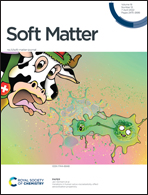Dynamic ionic behavior of gel-free diolefin rubber-based carboxylate ionomers prepared via olefin metathesis†
Abstract
Constructing dynamic ionic bonding interactions is acknowledged as an efficient strategy to improve the physical–mechanical characteristics of rubber materials, and to provide them with some novel features such as self-healing. However, currently reported grafting-modification approaches such as free-radical and anionic reactions inevitably induced the generation of rubber gels, which is unfavorable for their practical applications. In this work, we fabricated a gel-free carbonylated diolefin rubber based on the olefin metathesis reaction. Furthermore, a diolefin rubber-based ionomer was prepared through the complexation of carbonylated diolefin rubber and sodium hydroxide. Compared with pure diolefin rubber, the resultant ionomers exhibited a higher glass transition temperature (Tg), higher mechanical strength and higher damping properties. Moreover, these ionomers were provided with apparent self-healing behavior. This was primarily because of the increased dynamic ionic bonding interactions induced by the formation of multi-ion-pair cluster structures, a unique intermolecular interaction that exists in the ionomers. Consequently, the gel-free diolefin rubber-based ionomers offer some brand-new applications, such as artificial skin and high-performance “green” tires.



 Please wait while we load your content...
Please wait while we load your content...